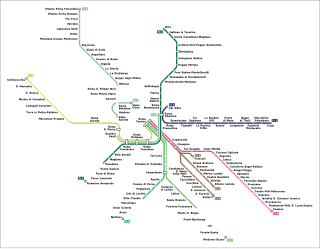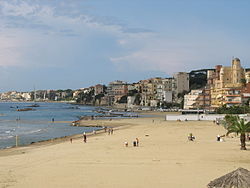
Anzio is a town and comune on the coast of the Lazio region of Italy, about 51 kilometres (32 mi) south of Rome.

Antium was an ancient coastal town in Latium, south of Rome. An oppidum was founded by people of Latial culture, then it was the main stronghold of the Volsci people until it was conquered by the Romans.

Velletri is an Italian comune in the Metropolitan City of Rome, approximately 40 km to the southeast of the city centre, located in the Alban Hills, in the region of Lazio, central Italy. Neighbouring communes are Rocca di Papa, Lariano, Cisterna di Latina, Artena, Aprilia, Nemi, Genzano di Roma, and Lanuvio. Its motto is: Est mihi libertas papalis et imperialis.

Via Severiana was an ancient Roman road in central Italy leading in Latium, running southeast from Portus to Tarracina, a distance of 80 Roman miles along the coast. A restoration and reunion of existing roads was carried out with a work of lastrification in 198–209 AD, during the reign of emperor Septimius Severus, in order to connect more quickly the maritime towns of Ostia, Lavinium, Ardea, Antium and the routes that came there from Rome.

Artena is a town and comune in the Metropolitan City of Rome, Italy. It is situated in the northwest of Monti Lepini, in the upper valley of the Sacco River. It is approximately 40 kilometres (25 mi) southeast by rail, and 30 kilometres (19 mi) direct from Rome.

Torre Astura, formerly an island called by the ancients merely Astura, is now a peninsula in the comune of Nettuno, on the coast of Latium, Italy, at the southeast extremity of the Bay of Antium, on the road to Circeii. The name also belongs to a medieval coastal tower in the same site, as well as to the river which rises at the southern foot of the Alban Hills, and has a course of about 33 km before flowing into the sea immediately to the southeast.

Satricum, an ancient town of Latium vetus, lay on the right bank of the Astura river some 60 kilometres (37 mi) SE of Rome in a low-lying region south of the Alban Hills, at the NW border of the Pontine Marshes. It was directly accessible from Rome via a road running roughly parallel to the Via Appia.

Lavinio is a small sea side tourist town in the Lazio region of Italy, 50 kilometres (31 mi) southwest of Rome. It is part of the municipality of Anzio.
The 220th Coastal Division was an infantry division of the Royal Italian Army during World War II. Royal Italian Army coastal divisions were second line divisions formed with reservists and equipped with second rate materiel. They were often commanded by officers called out of retirement.
Cincinnato is a small sea side vacation area in the Lazio region of Italy, 50 kilometres (31 mi) southwest of Rome. It is part of the municipality of Anzio. The area consists mainly of summer vacation homes and beach clubs serving Romans.

Fausto Calogero Pirandello was an Italian painter belonging to the modern movement of the Scuola romana . He was the son of Nobel laureate Luigi Pirandello.

Joseph Pace is an Italian painter and sculptor.

The FL8 is a regional rail route. It forms part of the network of the Lazio regional railways, which is operated by Trenitalia, and converges on the city of Rome, Italy.

Forte Sangallo, also known as the Fortezza di Nettuno, is a Renaissance fortification built on the Tyrrhenian Sea, in the historic village of the City of Nettuno, in the south of Rome. The fortification is a very popular tourist destination today with its well-preserved old quarter with narrow streets and small squares.

Annibale Lippi was an Italian architect active during the second half of 16th century. He was son of the sculptor and architect Nanni di Baccio Bigio. Pupil of Francesco Salviati, his only certain works are the church of Our Lady of Loreto at Spoleto, built around 1572, where he adopts a Vignola style, the churches of Santa Maria a Monte Cavallo and Santa Maria della Pietà a Piazza Colonna, both in Rome. The Villa Medici in Rome, who used to be assigned to it, is probably due to his father, but he worked there during the construction. In Rome Lippi restored the Palazzo dei Convertendi at Piazza Scossacavalli in Borgo, when this was bought by Cardinal Francesco Commendone (1523–84), and gave to the building its definitive facade. In 1578 he appeared among the members of the Accademia dei Virtuosi at Pantheon. He died after 18 November 1581 when, already ill, wrote his testament, and was buried in the family tomb in Trinità dei Monti in Rome.

The following outline is provided as an overview of and topical guide to Rome:

Piazza Scossacavalli, also named Piazza di San Clemente, Piazza di Trento, Piazza d'Aragona, Piazza Salviati, was a square in Rome, Italy, important for historical and architectonic reasons. The square was demolished together with the surrounding quarter in 1937 due to the construction of Via della Conciliazione.

The Palazzo del Governatore di Borgo, also called Palazzo delle Prigioni di Borgo, Palazzo del Soldano, or Palazzo dal Pozzo, was a Renaissance palace in Rome, important for artistic and historical reasons. Designed by Antonio da Sangallo the Younger, it was demolished in 1936 for the opening of Via della Conciliazione.

Palazzo Colonna is a historic building in the center of Marino, in the Roman Castles area of the Metropolitan City of Rome, Italy. Currently, it houses the municipal headquarters of the municipality of Marino.
The history of the city of Marino, in the province of Rome, in the Roman Castles area, begins with the appearance of the first human settlements in the municipal territory during the Bronze Age. In the Middle Ages the castle knew its period of greatest splendor under the rule in turn of the Counts of Tusculum, the Frangipane, the Orsini, the Apostolic Chamber, the Caetani, and finally the Colonna, of whom it was a historic stronghold. Marinese events have often been of considerable importance in the local and sometimes even international historical context, so much so that various scholars in various eras have tried their hand at collecting the historical memories of this town. The castle was besieged several times, with mixed results, suffering at least four sackings and two destructions a fundamentis. However, the feudal lords and the community have been concerned at all times to erect monuments for public ornament, such as the only example of Gothic architecture in the Roman Castles, the former church of Santa Lucia, the sanctuary of Santa Maria dell'Acquasanta, the Frangipane and Orsini fortresses, Palazzo Colonna, the collegiate basilica of San Barnaba, Palazzo Matteotti, and many other public works. Numerous important personalities in politics, the arts, religion, and finance were also born, lived, or related in some way in Marino.






















